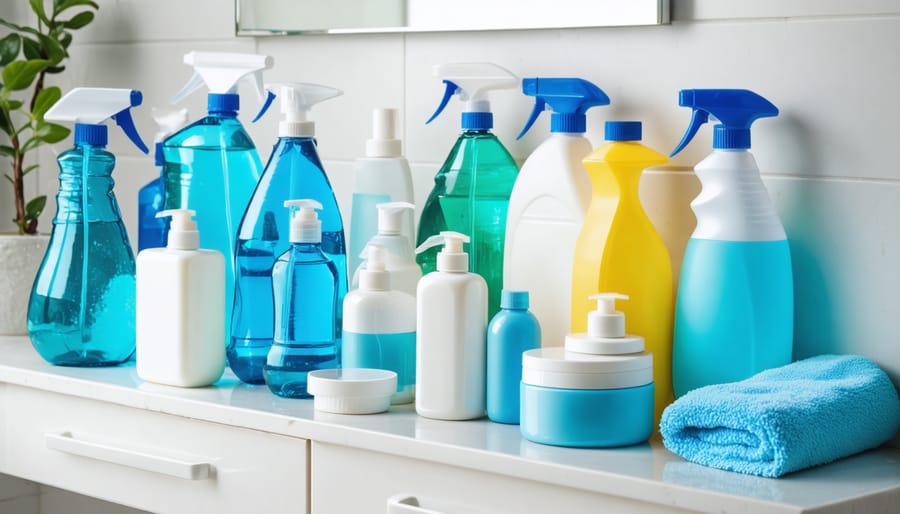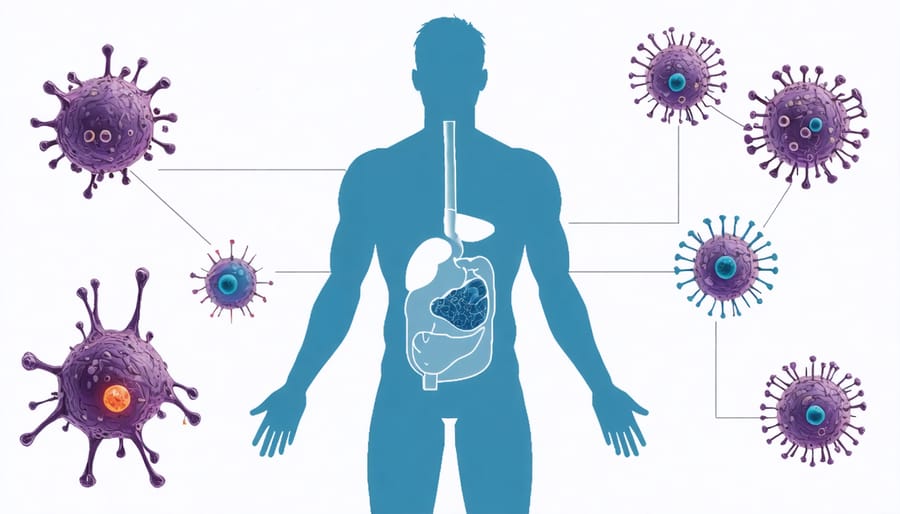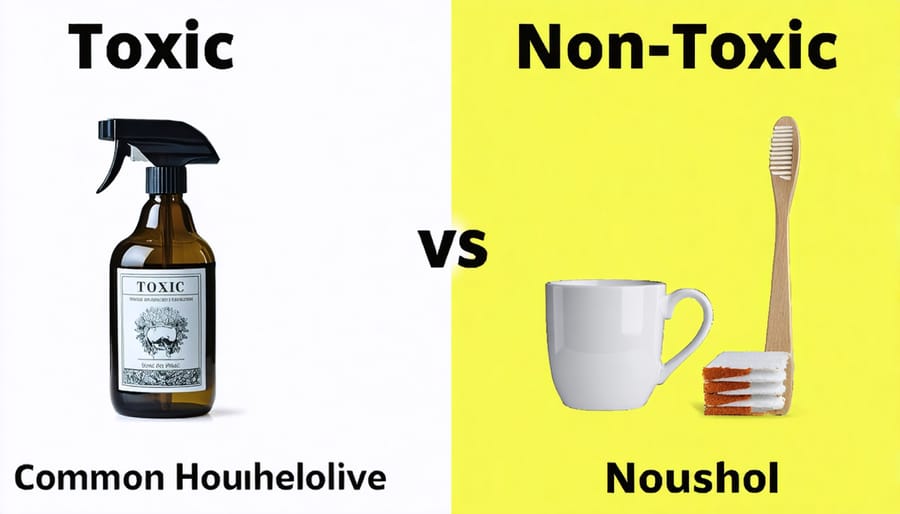Environmental toxins silently disrupt our natural hormone balance daily through countless everyday products and exposures. From BPA-lined food containers to pesticide-treated produce, these harmful compounds accumulate in our bodies, potentially triggering serious health issues including thyroid dysfunction, reproductive problems, and metabolic disorders. While completely avoiding these toxins may be impossible in modern life, understanding their sources and implementing strategic lifestyle changes can significantly reduce your exposure and protect your health.
Recent Canadian environmental health studies reveal that the average person carries over 200 synthetic chemicals in their body, with many of these compounds directly interfering with hormone signaling pathways. This disruption can manifest as unexplained weight gain, chronic fatigue, mood disorders, and fertility challenges. The good news? Simple, practical steps like choosing organic produce, filtering drinking water, and avoiding plastic food containers can dramatically decrease your toxic load and support your body’s natural detoxification processes.
By making informed choices about the products we use and the environments we create in our homes, we can take control of our exposure to these harmful compounds and protect our long-term health.
Common Environmental Toxins in Your Daily Life
Household Products and Personal Care Items
Many common household and personal care products contain potentially harmful chemicals that can disrupt our endocrine system and overall health. Cleaning products often include phthalates, triclosan, and synthetic fragrances, which have been linked to hormonal imbalances and respiratory issues. These chemicals can enter our bodies through skin contact or inhalation during regular household cleaning activities.
Cosmetics and personal care items frequently contain parabens, commonly used as preservatives, and synthetic musks found in perfumes and lotions. These substances can be absorbed through the skin and may accumulate in body tissues over time. Beauty products like nail polish, hair dyes, and some moisturizers may contain formaldehyde, lead, and other heavy metals that pose potential health risks.
To reduce exposure to these toxins, consider these practical steps:
– Choose natural cleaning alternatives like vinegar, baking soda, and lemon
– Read product labels carefully and avoid items with “fragrance” or “parfum”
– Select personal care products with minimal ingredients
– Opt for natural, mineral-based cosmetics
– Use essential oils instead of synthetic air fresheners
– Choose unscented or naturally scented products
– Store cleaning products in well-ventilated areas
When transitioning to safer alternatives, start by replacing products you use most frequently. This gradual approach makes the switch more manageable while significantly reducing your daily exposure to harmful chemicals.

Food and Water Contaminants
Our daily exposure to toxins often comes from common sources we might not suspect. Food packaging, particularly plastic containers and can linings, can contain harmful chemicals like BPA and phthalates that leach into our food. These substances are known endocrine disruptors, and how these food choices affect hormone balance is becoming increasingly clear through research.
In our water supplies, common contaminants include heavy metals like lead and mercury, agricultural runoff containing pesticides, and pharmaceutical residues. While Canadian water treatment facilities work hard to remove these substances, some may still persist in tap water, especially in older buildings with dated plumbing systems.
Pesticides used in conventional farming can leave residues on fruits and vegetables. The “Dirty Dozen” list, updated annually, helps consumers identify produce with typically higher pesticide levels. Choosing organic options for these items can help reduce exposure to harmful chemicals.
To minimize exposure to these contaminants, consider practical steps like:
– Using stainless steel or glass food containers
– Installing a quality water filter
– Washing produce thoroughly
– Choosing organic when possible for high-risk items
– Avoiding canned foods with BPA linings
– Using reusable water bottles made from safe materials
These simple changes can significantly reduce your daily exposure to common food and water contaminants while maintaining a healthy, balanced diet.
How These Toxins Affect Your Hormonal System
The Endocrine System Under Attack
Our endocrine system plays a crucial role in regulating everything from metabolism and growth to sleep and mood through the careful balance of hormones. Unfortunately, many environmental toxins can disrupt this delicate system, acting as endocrine disruptors that interfere with hormone production, transport, and function.
These disruptors can mimic natural hormones, block hormone receptors, or alter how hormones are produced and broken down in the body. Common examples include BPA from plastic containers, phthalates in personal care products, and certain pesticides found on conventional produce. Even small amounts of these substances can impact hormone function, potentially leading to various health issues.
The thyroid gland is particularly vulnerable to environmental toxins. Chemicals like perchlorate, found in some drinking water, can interfere with iodine uptake, affecting thyroid hormone production. Similarly, certain flame retardants can mimic thyroid hormones, disrupting the body’s natural processes.
Reproductive hormones are also at risk. Studies show that exposure to certain plasticizers can affect estrogen and testosterone levels, potentially impacting fertility, development, and reproductive health. Additionally, some pesticides and herbicides have been linked to changes in cortisol levels, affecting our stress response and energy regulation.
The cumulative effect of multiple toxins, often called the “cocktail effect,” can be more significant than exposure to individual substances. This understanding has led to growing concern about the combined impact of various environmental toxins on hormonal health, especially during critical developmental periods.

Signs Your Hormones Are Being Disrupted
Recognizing hormone disruption early can help you take action before more serious health issues develop. Common signs include unexplained weight changes, particularly weight gain around the midsection, and persistent fatigue that doesn’t improve with rest. Many people experience irregular sleep patterns, finding it difficult to fall asleep or stay asleep throughout the night.
Mood changes are another significant indicator, often manifesting as anxiety, depression, or irritability. These emotional fluctuations can be intensified by stress-related hormone disruption, creating a challenging cycle for many individuals.
Women might notice irregular menstrual cycles, severe PMS symptoms, or unusual breast changes. Men commonly report decreased libido, difficulty building muscle, or unexplained breast development. Both men and women may experience hair loss, dry skin, or recurring acne.
Digestive issues often accompany hormone disruption, including bloating, constipation, or persistent stomach discomfort. Many people notice changes in their energy levels throughout the day, experiencing sudden crashes or difficulty concentrating.
Temperature regulation problems, such as feeling unusually cold or experiencing frequent hot flashes, can also indicate hormonal imbalances. Some individuals report increased sensitivity to environmental factors they previously tolerated well.
If you’re experiencing several of these symptoms, especially if they’re persistent or worsening, it’s important to consult with a healthcare provider. They can help determine whether environmental toxins might be contributing to your hormone disruption and develop an appropriate treatment plan.
Practical Steps to Reduce Your Toxic Exposure
Smart Shopping Choices
Making informed shopping choices is one of the most effective ways to reduce your exposure to environmental toxins. Start by prioritizing organic produce, especially for items known to have high pesticide residues like strawberries, spinach, and apples. When organic options aren’t available, thoroughly wash conventional produce and consider seasonal, locally grown alternatives.
When selecting personal care products, read labels carefully and avoid items containing parabens, phthalates, and artificial fragrances. Look for natural alternatives and products certified by trusted organizations. For skincare and cosmetics, fewer ingredients often means less potential for toxic exposure.
Choose household cleaning products with natural ingredients like vinegar, baking soda, and essential oils. Many conventional cleaners contain harsh chemicals that can affect hormone function and respiratory health. If using traditional cleaning products, ensure proper ventilation and consider wearing gloves.
For food storage and preparation, opt for glass or stainless steel containers instead of plastic, especially when heating food. If using plastic containers, check for the recycling code and avoid those marked with #3, #6, or #7, which may contain harmful chemicals.
When purchasing furniture or home décor, look for items made from natural materials and finished with low-VOC or no-VOC products. Be particularly careful with items for children’s rooms, as young ones are more susceptible to environmental toxins.
Consider using a water filter certified to remove common contaminants, and regularly check your local water quality reports. For clothing, choose natural fibers when possible and wash new items before wearing to remove potential chemical residues.

Home Environment Improvements
Creating a healthier home environment is essential for reducing exposure to environmental toxins. Start by improving your indoor air quality through regular ventilation and using high-quality air purifiers with HEPA filters. Consider adding indoor plants like spider plants or peace lilies, which naturally filter air pollutants.
Replace conventional cleaning products with natural alternatives like vinegar, baking soda, and essential oils. When purchasing new furniture or carpeting, look for items certified as low-VOC (volatile organic compounds) to minimize off-gassing of harmful chemicals into your living space.
In the kitchen, store food in glass or stainless steel containers instead of plastic to avoid chemical leaching. Use a high-quality water filter to remove contaminants from drinking water, and consider installing a shower filter to reduce chlorine exposure during bathing.
Pay attention to your bedroom environment, where you spend approximately one-third of your life. Choose organic bedding materials when possible, and ensure your mattress is made without harmful flame retardants. Keep electronics out of the bedroom to reduce EMF exposure during sleep.
Regular dusting with a damp cloth helps remove toxin-laden dust particles, while taking shoes off at the door prevents tracking in outdoor pollutants. Consider using natural fiber rugs and carpets instead of synthetic materials, which can off-gas chemicals.
Maintain proper humidity levels (between 30-50%) to prevent mold growth, and address any water leaks promptly. Regular maintenance of HVAC systems, including changing filters, helps ensure cleaner air circulation throughout your home.
These simple changes can significantly reduce your exposure to environmental toxins and create a healthier living space for you and your family.
Lifestyle Changes That Make a Difference
Making simple changes to your daily routine can significantly reduce your exposure to environmental toxins. Start by switching to natural cleaning products or making your own using ingredients like vinegar and baking soda. When it comes to personal care products, opt for items with fewer ingredients and avoid those containing parabens, phthalates, and synthetic fragrances.
In the kitchen, store food in glass or stainless steel containers instead of plastic, and never heat food in plastic containers. Choose organic produce when possible, especially for items on the “Dirty Dozen” list, which typically have higher pesticide residues. Filtering your tap water can remove many common contaminants and reduce your exposure to harmful chemicals.
Regular cleaning and ventilation of your home helps eliminate indoor air pollutants. Consider adding air-purifying plants like spider plants or peace lilies to naturally improve air quality. When renovating, choose low-VOC paints and natural building materials to minimize toxic exposure.
Your body’s natural detoxification systems, particularly the relationship between gut health and hormones, play a crucial role in managing toxin exposure. Support these systems by staying hydrated, eating plenty of fiber-rich foods, and incorporating detoxifying foods like leafy greens, cruciferous vegetables, and herbs into your diet.
Regular exercise and sweating through physical activity or sauna use can also help your body naturally eliminate toxins. Remember, small changes add up to make a significant difference in reducing your overall toxic load.
Environmental toxins are an ever-present concern in our modern world, but understanding their impact and taking proactive steps can significantly reduce our exposure and protect our health. Throughout this article, we’ve explored how various toxins can affect our hormonal system, immune function, and overall well-being.
Remember that while it’s impossible to eliminate all exposure to environmental toxins, every step toward reduction matters. Start by making simple changes in your daily routine: choose organic produce when possible, filter your drinking water, use natural cleaning products, and minimize plastic use in food storage and preparation.
Regular detoxification support through healthy lifestyle choices can also make a difference. Focus on eating plenty of fiber-rich foods, staying well-hydrated, and maintaining regular exercise to support your body’s natural detoxification processes. Consider incorporating more cruciferous vegetables, which contain compounds that help your body process and eliminate toxins more effectively.
Take time to assess your home environment and make gradual improvements. Replace old plastic containers with glass or stainless steel alternatives, ensure proper ventilation, and use natural air purifiers like indoor plants. These small but meaningful changes can add up to significant benefits for your long-term health.
By staying informed and making conscious choices, you can create a healthier environment for yourself and your family while supporting your body’s natural ability to handle environmental challenges.

